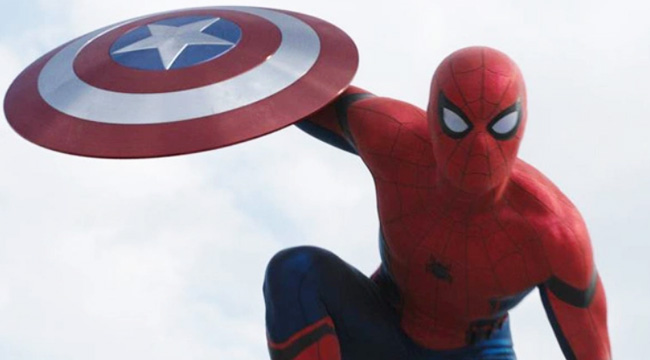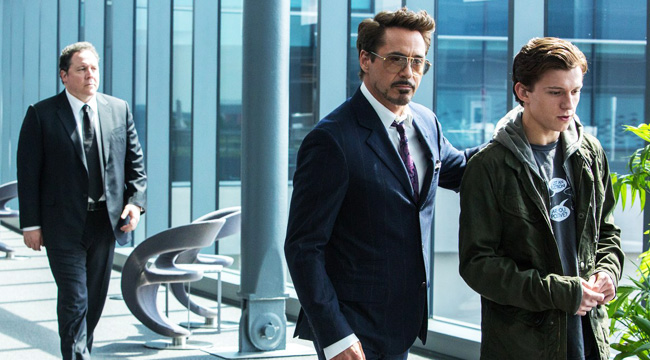
(This piece is spoiler-free for Spider-Man Far From Home, but if you haven’t seen Avengers: Endgame yet, consider yourself warned.)
It’s not much of an exaggeration to say that everything’s coming up Spidey these days. Peter Parker shot his web all over the MCU and now holds the honor of wrapping up Phase Three with Spider-Man: Far From Home. Sony’s also so pumped by their own Spider-Success with Spider-Man: Into The Spider-Verse and the Spidey-associated Venom that they’re hatching several spinoffs, including the Morbius film that’s coming in 2020. We’re gonna stick with (mostly) talking about the MCU’s Tom Holland incarnation for this discussion. Clearly though, Sony couldn’t be more pleased about licensing Spider-Man to Marvel Studios and Disney, and that’s led to an even more accessible and, frankly, more entertaining version of Peter Parker than we’ve seen on the big screen. This turn of events benefits all parties involved, and much of this triumph has to do with Parker’s relationship with Tony Stark in the Marvel movies, which is quite unlike their retort-filled comic-book origins.
Let’s get real about why all of this is currently possible. Yes, Tobey Maguire was more than serviceable in Sam Raimi’s films (even though things got weird and controversially emo at the end) for Sony, but Andrew Garfield’s too-serious version for Marc Webb didn’t quite connect. The combined inertia of those five movies definitely meant that a full-on Parker retread of the spider bite and his family history would be overkill. It was time for a fresh approach, and the new execution was on point. That’s a big part of why Parker and director Jon Watts (although, credit where it is due, the Russo Brothers helmed Spidey’s Civil War introduction) can claim the “great power [and] great responsibility” of grabbing Marvel fans’ hands and swinging into the future with them.
Another key aspect when it comes to Spider-Man’s current position in the MCU is this — Parker is near and dear to the fandom, so any emotional investment from him will be echoed by the audience. Throughout the comics and the Sony movies, he’s always resonated with the everyperson’s struggles, but Holland’s version runs both shallower and deeper in a fascinating way. His overeager, entirely nerdy Spidey has been meme’d into oblivion, and while Parker’s troubled family background hasn’t been erased or downplayed in a significant way, Holland’s version is decidedly lighter than Maguire or Garfield’s takes. For the tone of the MCU, the approach works splendidly, along with clearing out headspace for his relationship with Tony Stark. So even though the MCU hasn’t done a deep dive into Parker’s tribulations, there was a longer game planned, which is why the strategy to have a standalone Parker movie end Phase Three is brilliant. Spidey means a lot to a lot of people, and that goodwill will solidify the MCU’s position for the future at a time when people cynically claim to be tired of watching comic-book movies.
Look, there are endless “What Spider-Man Means To Me” pieces out there, and I’m not going to add to the pile. Yet it’s worth stressing how Peter Parker reverberates with comic book fans who straddle countless demographics. His greatest downfall is the inability to separate emotion from his heroic acts, but that’s also one of his appeals. Parker stands for the underdog and symbolizes hope. Despite all of his own struggles, he still shows up to get the sh*t beat out of him while fighting for those who are stuck in even worse circumstances than his own. He persists in inserting himself into dangerous situations, and he honed his own superpowers while refining his web shooters on his own, which is pretty damn cool. When Parker first showed up in Captain America: Civil War, he didn’t have the public support of Cap or the reality-bending abilities of Scarlet Witch or the engineering prowess of Stark. Yet the Kid didn’t do so bad alongside his fellow Avengers, and boy, was he excited to join the fight.
Yet let’s not forget that Parker was already doing his web-tossing thing by himself, and he was largely pulled onto the team because Tony Stark wanted an edge against Team Cap. He found that in Parker, whose agility, speed, and physical strength allowed him to maneuver against his comparatively clunky opponents. He was able to wrap up Cap in webbing and nab his shield! More than that, he was a non-lethal chess piece who didn’t stand much chance of injuring himself, which was important from a Stark PR standpoint because no one wants a teen to get hurt. Ultimately though, Stark did not hesitate to tell Parker when to stop fighting — the kid started to get carried away — and he wasn’t afraid to take away the tricked out costume as punishment during Homecoming. Stark started to take his responsibilities as a surrogate father seriously, and a beautiful relationship took root.

From a storytelling perspective, the MCU’s focus on the Parker-Stark dynamic is something to relish in the ocean of reboots where we currently reside. His arrival in Civil War careened into a different arena than Parker had found himself in other movies. He annoyed the hell out of Black Widow, and my god, he was cell phone obsessed, but Spider-Man was thrilled to be hanging alongside other heroes like he does in the comics. And although Civil War kept Parker very light (he was mostly a tool in the Stark-Steve Rogers beef), Homecoming fleshed out his relationship with Stark while forcing him to conquer deep-seated fears. Throughout, Holland continued to show how Parker can rise above his own struggles and protect others while holding onto his own ideals and personality. This was especially the case while he faced high stakes like stopping the Vulture’s heisting, struggled through self-doubt and terror while trapped under rubble, and saved lives at the Washington Monument. Parker learned that he could be truly heroic on his own, which was an important stepping stone on the way to rejoining a team approach.
Following the events of Infinity War and Endgame — with Stark wrecked after losing Parker during the snap, and Parker crushed when Tony sacrificed himself to defeat Thanos — we can now fully grasp the emotional heft of their connection. Yet Parker (and the audience) didn’t quite have the space or time to finish reckoning with Stark’s death in Endgame, and he must deal with the emotional weight of his loss. So, it’s up to Far From Home to not only do that but wrap up the Infinity Saga while grabbing the baton for Phase Four, and those two tasks are integral to each other. According to Marvel Studios chief Kevin Feige, that was part of the long-term plan for Spidey all along. Far From Home can extend the goodbye to the beloved Iron Man (Stark may not officially be “The First Avenger” — that’s Captain America — but he was the first one with his own MCU movie) before looking toward different focuses and settings.
While arriving at Far From Home, it’s also important to note that, in losing Stark, Parker’s back to doing things on his own, pre-Avengers style. That’s something that Marvel Studios creative executive Eric Caroll told ComicBook.com “was really important to the arc of this movie that there not be other Avengers available to Nick Fury or Peter, so he’d have to step up and do it himself.” Sure, Happy Hogan is there, and Jake Gyllenhall’s Mysterio is obviously also making a huge impression, but we’re still focusing on Holland’s Parker. He’s endured tons since first surfacing in 2016, but he’s the kid who will formally bring the decade-long Infinity Saga to an end. So what’s next for Peter Parker? A lot, although to say more would venture into Far From Home spoiler territory. Plenty of rumors are also swirling about a future Venom/Spidey crossover, and there’s whispers of the Sinister Six happening, and so on. For now, fans can rest assured that Spider-Man: Far From Home will satisfyingly end Phase Three and shine light on a promising MCU future.
Spider-Man: Far From Home arrives on July 2.
